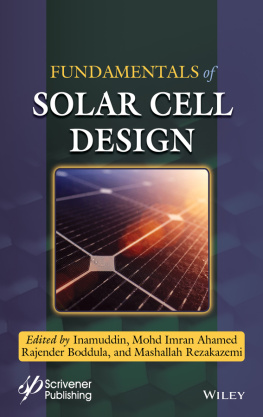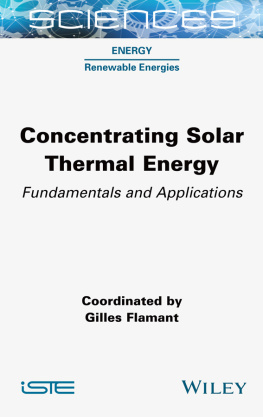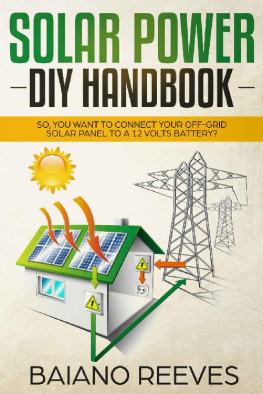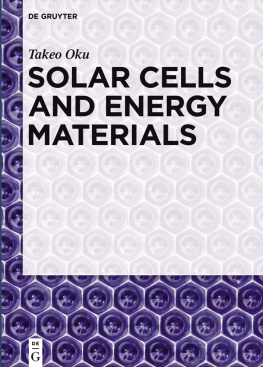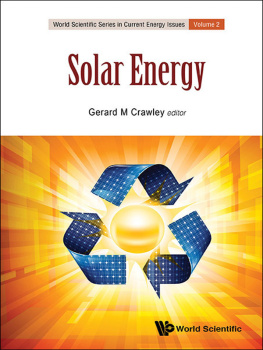
Scrivener Publishing
100 Cummings Center, Suite 541J
Beverly, MA 01915-6106
Publishers at Scrivener
Martin Scrivener ()
Phillip Carmical ()
Fundamentals of Solar Cell Design
Edited by
Inamuddin,
Mohd Imran Ahamed,
Rajender Boddula,
and
Mashallah Rezakazemi

This edition first published 2021 by John Wiley & Sons, Inc., 111 River Street, Hoboken, NJ 07030, USA and Scrivener Publishing LLC, 100 Cummings Center, Suite 541J, Beverly, MA 01915, USA
2021 Scrivener Publishing LLC
For more information about Scrivener publications please visit www.scrivenerpublishing.com.
All rights reserved. No part of this publication may be reproduced, stored in a retrieval system, or transmitted, in any form or by any means, electronic, mechanical, photocopying, recording, or otherwise, except as permitted by law. Advice on how to obtain permission to reuse material from this title is available at http://www.wiley.com/go/permissions.
Wiley Global Headquarters
111 River Street, Hoboken, NJ 07030, USA
For details of our global editorial offices, customer services, and more information about Wiley products visit us at www.wiley.com.
Limit of Liability/Disclaimer of Warranty
While the publisher and authors have used their best efforts in preparing this work, they make no representations or warranties with respect to the accuracy or completeness of the contents of this work and specifically disclaim all warranties, including without limitation any implied warranties of merchantability or fitness for a particular purpose. No warranty may be created or extended by sales representatives, written sales materials, or promotional statements for this work. The fact that an organization, website, or product is referred to in this work as a citation and/or potential source of further information does not mean that the publisher and authors endorse the information or services the organization, website, or product may provide or recommendations it may make. This work is sold with the understanding that the publisher is not engaged in rendering professional services. The advice and strategies contained herein may not be suitable for your situation. You should consult with a specialist where appropriate. Neither the publisher nor authors shall be liable for any loss of profit or any other commercial damages, including but not limited to special, incidental, consequential, or other damages. Further, readers should be aware that websites listed in this work may have changed or disappeared between when this work was written and when it is read.
Library of Congress Cataloging-in-Publication Data
ISBN 9781119724704
Cover image: Pixabay.com
Cover design by Russell Richardson
Set in size of 11pt and Minion Pro by Manila Typesetting Company, Makati, Philippines
Printed in the USA
10 9 8 7 6 5 4 3 2 1
Preface
Solar cells are semiconductor devices that convert light photons into electricity in photovoltaic energy conversion and can help to overcome the global energy crisis. Solar cells have many applications including remote area power systems, earth-orbiting satellites, wristwatches, water pumping, photodetectors, and remote radiotelephones. Solar cell technology is economically feasible for commercial-scale power generation. While commercial solar cells exhibit good performance and stability, still researchers are looking at many ways to improve the performance and cost of solar cells via modulating the fundamental properties of semiconductors. Solar cell technology is the key to a clean energy future. Solar cells directly harvest energy from the suns light radiation into electricity are in an evergrowing demand for future global energy production. Solar cellbased energy harvesting has attracted worldwide attention for their notable features, such as cheap renewable technology, scalable, light-weight, flexibility, versatility, no greenhouse gas emission, environment, and economy friendly, and operational costs are quite low compared to other forms of power generation. Thus, solar cell technology is at the forefront of renewable energy technologies which are used in telecommunications, power plants and small devices to satellites. Aiming at large-scale implementation can be manipulated by various types used in solar cell design and exploration of new materials toward improving performance and reducing cost. Therefore, in-depth knowledge about solar cell design is fundamental for those who wish to apply this knowledge and understanding in industries and academics.
This book provides a comprehensive overview on solar cells and explores the history to evolution and present scenarios of solar cell design, classification, properties, various semiconductor materials, thin films, wafer-scale, transparent solar cells, and so on. It also includes solar cells characterization analytical tools, theoretical modeling, practices to enhance conversion efficiencies, applications, and patents. This book is a unique reference guide that can be used by faculty, students, researchers, engineers, device designers, and industrialists who are working and learning in the fields of semiconductors, chemistry, physics, electronics, light science, material science, flexible energy conversion, industrial, and renewable energy sectors. This book includes the 16 chapters and the summaries are given below.
highlights a variety of organic solar cells, documented in recent literature, developed to study solar cell efficiencies, with polymer donors and organic small molecule acceptors or as donors and acceptors.
discusses the plasmonic solar cells with a focus on the fundamental principle of solar cell, types and design of plasmonic metallic nanostructures and devices, novel properties of surface plasmon resonance, and energy conversion efficiency. The chapter explains about device mechanisms, solar cell design, and advancements in plasmonic solar cells to generate clean energy and solar fuels.
discusses the current problem of the energy crisis, depletion of conventional energy resource, and serious threat of global warming. The chapter discusses the Tandem solar cells developments in the last few years.
discusses solar cells based on three different thin films, e.g., amorphous silicon, cadmium telluride, and copper indium gallium selenide. Additionally, the structure of thin films and various coating techniques are discussed. Moreover, this chapter summarizes the modifications and performance improvement of thin-film solar cells.
comprises a brief discussion about the biohybrid solar cells, suitable substrate selection for fabrication, as well as the role of photosynthesis in biohybrid solar cells. The chapter discusses some biomimetic approaches borrowed from photosynthetic organisms and plants which can be implemented in biohybrid solar cells.
deals with various features of dye-sensitized solar cells (DSSCs). Here, the simple construction and working mechanism besides various components of DSSCs are elaborately discussed. Also, the various materials used for electrolytes and natural dyes are explained briefly along with performances of DSSCs.
addresses various computational methodologies from molecular mechanics to quantum mechanics for evaluation of compounds in terms of structural and electronic properties. The main objective is the assessment of photovoltaic parameters including absorption spectra, charge transfer, open-circuit voltage, peak current density, efficiency in light, and molecular descriptors toward the efficient performance of solar cells.
Next page
